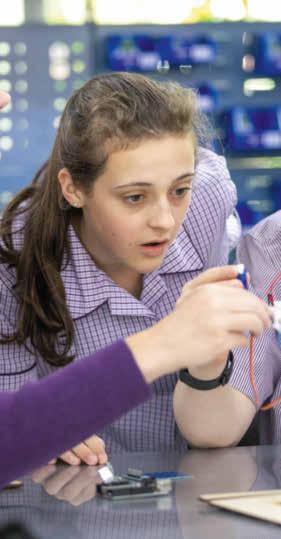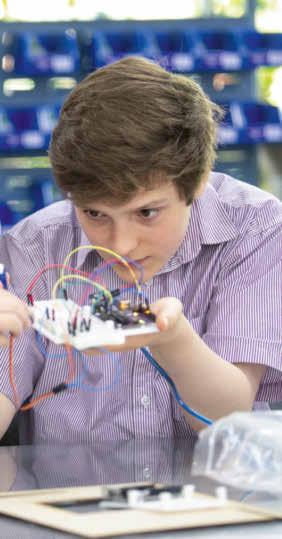
5 minute read
Presbyterian Ladies’ College
Principal Cheryl Penberthy
An inspiring leader at the forefront of women’s education, Cheryl is passionate in preparing young women for every opportunity and to develop the skills, outlook and character they need to become the leaders of tomorrow. 141 Burwood Highway, Burwood VIC 3125
Advertisement
For almost 150 years, PLC has been at the forefront of girls’ education. We strongly believe in inspiring our students to follow their passions, explore every opportunity and achieve to the very best of their abilities.
Nurtured within a strong Christian community, our girls care and respect one another, acquiring the skills and selfdiscipline they need to be global citizens with an informed understanding of other cultures and the world around them.
At PLC our focus is on the development of the whole student. Our holistic wellbeing program supports each girl’s academic, emotional, social, creative, physical and spiritual wellbeing. Personal achievement across all areas of ability and endeavour are carefully nurtured and celebrated as part of their individual learning journey.
Located on 16-hectares of magnificent park-like gardens, students from ELC to Year 12 and Boarding have unbounded space to live, work and play. Our beautiful natural surroundings help stimulate their learning and offers ample space for personal exploration, quiet reflection and active physical engagement.
We encourage families to visit during one of our many School Tours and see first-hand what sets us apart and discover why your daughter will benefit from a life-changing educational experience at PLC.
THE BASICS
Enquiries
+61 3 9808 5811 plc.vic.edu.au admissions@plc.vic.edu.au
Years
Boarding: Years 7 – 12
Denomination Presbyterian
Gender
ELC – coeducational. Prep to Year 12 – girls only
Fees
19,388 – $34,008
Boarding \ Yes
Scholarships \ Yes
ATAR \ Median 95.2*
* Results are provided by the school, Domain does not warrant their accuracy
WELLBEING
Our holistic Student Wellbeing program is designed to support each girl at the different stages of her development; balancing resilience with a healthy and positive mindset and providing the knowledge and skills to achieve her very best.
EXCELLENCE
PLC is proudly one of the Australia’s leading schools and is ranked as the No 1 NAPLAN school. Two thirds of girls achieve 90-plus ATARs in VCE and IB and they go on to become leaders across all fields of endeavour.
COMMUNITY
As a Christian school, PLC celebrates its faith and is committed to reflecting the loving nature of God in all areas of school life. We develop young women with strong values and beliefs and the strength and compassion to help those around them.
INNOVATION
Our teachers inspire our students from the earliest age to think beyond boundaries and to work collaboratively to solve complex problems utilising real-world technology and creative thinking within a global context.
TECHNOLOGY AND THE CLASSROOM
STEM subjects provide opportunities for critical thinking and problem solving.
BY PETER HANLON
NAVIGATING THE REAL WORLD
Micah Wilkins doesn’t remember the acronym STEM being used in his school days, which ended in the early 2000s, around the time it was popularised. Now, as head of digital learning and innovation at Camberwell Girls Grammar School, the catch-all for science, technology, engineering, and mathematics is part of his everyday world.
Yet for all of the advances made in how science and technology is taught in the classroom, the principle behind STEM learning remains the same as when Wilkins took on an elective called electronics in year 9 and used a soldering iron, among other tools, to construct a small recording device. (He laughs, recalling that his never actually worked, while another classmate’s exploded.)
“The thinking then is not dissimilar to what we’re trying to get our students to do now,” he says. “We’re working with real-world problems; we’re using tools of the trade; we are asking big questions and being curious with our learning.
Dean Pearman, head of digital learning and practice at Wesley College, agrees that for all of the wonderful learning environments that school Makerspaces and STEM laboratories now offer students, to see them as purely the domain of the technologically minded is to miss a crucial part of the picture.
At Wesley, digital technology studies sit under the holistic-approach-tolearning umbrella that envelops every class and subject, from prep to year 12. It recognises the importance of technology in the life of the community and is used not simply to design and build amazing things but to embed the necessary skills in cyber safety and in digital privacy and wellbeing that will help young people thrive after walking out through the school gate for the last time.

STEM and what it means,” Pearman says. “When you start to suggest that you have to be innately good at technology to be involved in STEM spaces and labs, you’re missing a whole range of other avenues in which students can work in that very same space.
At CGGS, a fleet of robots including NAO, DASH, EV3s and SPHERO help students learn coding, which Wilkins simplifies as “the language that sits behind all the web interfaces we see, all the apps we use and many of the games we play”. Yet behind the otherworldliness of the “bots” are much broader learning opportunities.
“Through robotics we ask, ‘How are we developing those important transferable skills such as critical thinking and creativity? How are we developing teamwork and organisation?’
“Doing STEM for us is, yes, you will learn some of those techy skills that are important. But underpinning that is a way of seeing and navigating the world that is more important,” says Wilkins.
“Many schools can talk about their laser cutters and 3D printers, their NAO bots and SPHEROs, but on the ground, what does it actually look like, and what does it mean for learning?
At Wesley, the remote learning experience of 2020 underscored for Pearman that technology at its core is a building material, and that young people will find meaningful ways to use it no matter what hurdles appear in their path. The broader benefits make the STEM experience all the more compelling.
“When you have been through our Makerspace or STEM lab during your educational journey at Wesley‚ to solve problems and be exposed to a designthinking process will set our students up for when they go into the workforce,” Pearman says.





